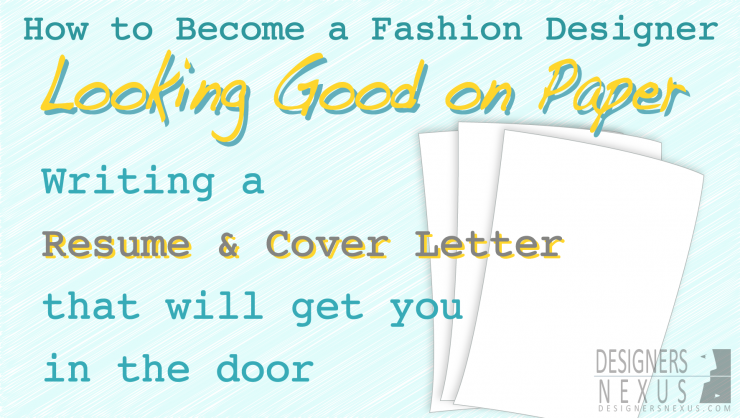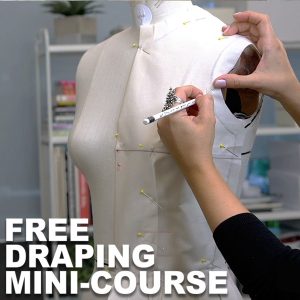Writing a Resume and Cover Letter
That Will Get You in the Door
How to Become a Fashion Designer ( Part 8 )
The resume is your marketing tool that will sell employers on the idea of interviewing you. Even if you're an ideal candidate for the position, if you don't look good on paper, recruiters won't give you a second glance. Not only do your skills and qualifications have to impress, but you need to make sure they stand out amongst the hundreds, and in some cases, thousands of other resumes that companies will receive for the same position. Keep reading to find out how to create a well organized, intelligent resume that will get you through the door!
What They Want to Know
Your resume should include the following information:
- Contact info: Basic information about yourself that also serves as your header. Include: Name, Address, Phone, and Email
- Objective: A brief statement (one or two sentences) describing the position you are seeking and how you hope to contribute to an employer.
- Education: Name of school, Years attended, Concentration, Degree received, GPA (if above 3.0)
- Qualifications/Skills: An itemized list describing relevant abilities such as knowledge of computer programs, languages, etc.
- Work Experience: chronological list of previous employers, starting with the most recent. Include position held, duration, and important responsibilities/accomplishments.
- Honors and Awards: List any honors and awards and year received.
- Course Highlights/Relevant Activities: If you have limited work experience, list course highlights, or relevant extracurricular activities, clubs, or organizations you may have participated in.
There are tons of resume creating resources and examples out there, many of which can be misleading and inaccurate. If you choose to seek more examples, make sure you select a reputable source. Click on the resume sample link below to see our example of a well formatted, clearly organized resume.
What They Don't Want to See
Knowing what not to include can be just as important as knowing what to include. When listing work responsibilities, don't over exaggerate - a professional recruiter can see right through an unrealistic resume. Also avoid making general statements- if you can, always list specifics to support your qualifications. For example, instead of citing "designed collection of dresses", state "designed and illustrated 5 piece dress collection for Fall 2007 collection". Giving specifics adds individuality and gives the recruiter better insight into your achievements.
When listing job responsibilities, it's a good idea to use action verbs to add variety to your statements. Write Express has a good variety of action verbs to choose from. And then of course are the basic resume no-no's: any personal info like age, religion, race, and salary requirements have no business in your resume.
Formatting
There are of course many different ways to format your resume, but keep in mind that your resume has only a few seconds to grad the recruiter's attention so if it's not easy to follow, you won't stand a chance! As an entry-level candidate or even after a few years of experience, your resume should not exceed one page. Recruiters won't care what high school you went to (unless it was industry specific), or what your hobbies are, so keeping your content concise and relevant to the desired position is a good way to maintain a reasonable length.
Just because your resume is clean and organized, doesn't mean you can't get a little creative with it. Experimenting with different fonts and coloring for your headers is one way to make your resume stand out amongst a sea of black and white. If your field is eveningwear, using a delicate script for your headers can be a great accent. Just remember to keep it simple- the fonts should still be legible and should support, not detract from your resume.
Presentation
While you will probably use Microsoft Word or a similar word processing program to create your resume, if your resume is going to be emailed, you should convert the file to PDF. When printing your resume, select a professional presentation paper. Your local stationery or office supply store has tons to choose from. Once again, paper choice should not detract from the content of your resume or affect its appearance if your resume is faxed or photocopied.
Cover Letter
Anytime you fax or email your resume, it should be accompanied by a cover letter. The first thing that recruiter reads, the contents of your cover letter should serve as an introduction and offers an opportunity to talk briefly about your background and knowledge of the company. You should definitely invest the time to make your cover letter well-written and well-focused. A poorly written, vague cover letter is a surefire way to get your resume overlooked.
Without repeating the details of your resume, introduce yourself to your prospective employer in three or four concise paragraphs including the following points:
- Why you are writing / the position of interest
- What you have to offer the company (accomplishments, work ethic etc)
- Your knowledge, enthusiasm and reasons for interest in the company
- Request an interview and specify how you will follow up
Keep in mind that the desired outcome of the cover letter is for the recruiter to take action so it should be tailored specifically to the company you're applying to instead of for a general position. Use your company research (you did research the company right?) and draw upon your knowledge of what they usually look for in successful employees to demonstrate how you can be an asset to their organization.
A quick word about following up: do it! I cannot tell you how many interviews I've received because I followed up after sending my resume. Not only does it demonstrate your follow up skills (very important) but it emphasizes your interest in the position. In one instance, a recruiter told me that from over 300 resumes he received, he contacted me for an interview because I was one of a handful of people who actually followed up. A handful (out of 300+) sounds like a pretty good way to make yourself stand out!
Once you've prepared your resume and cover letter, proofread them more than once to catch any mistakes or irrelevant information. Have a friend take a look to catch any mistakes you might have missed. When you've finished your resume, you're ready to begin applying for positions! Remember that even after you're hired, your resume should grow along with you. Keep it constantly updated as you gain experience and skills and when it's time for you to look for another position, you'll be glad you spent the time on it along the way.



